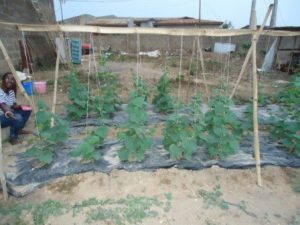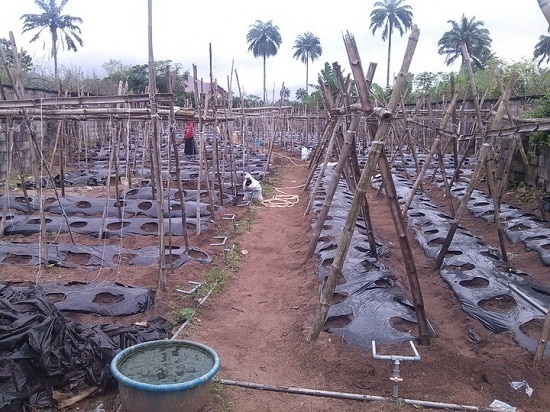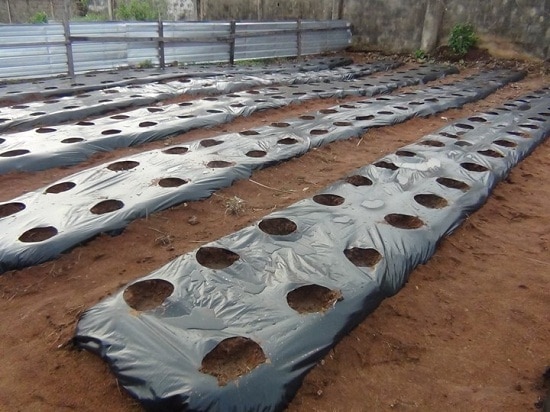Weeding is costly. Irrigation is also costly. If you have a large farm you’ll appreciate what I mean. Because of the labor intensive nature of weeding, laborers charge high prices for weeding. Money spent on fuel for irrigation is also costly. But thank God for mulching. It helps you to control weeds and conserve water at the same time.
Weeds compete with crops for nutrients and thus hampers growth. They also attract pests and diseases to the farm. One secret to having a bumper harvest is proper weed control – especially when the crops are young.

Fig 1: Cucumbers growing in plastic mulch. Image source: phollar Nairaland
A mulch is a layer of material covering the soil surface. It blocks sunlight from reaching weed seeds and thus prevent them from germinating. Because of the covering, most of the soil moisture will remain trapped in the soil. Mulches also help prevent soil-borne diseases by preventing rain from splashing soil on leaves.
Materials used for mulching can either be organic (straw, leaves etc) or synthetic (plastic films). For commercial farmers, plastic mulch is quite popular.
Organic Mulches: Organic mulches will decay with time and needs re-application. They are normally applied on the soil 2 inches thick. Some organic mulches like straw, sawdust, and other wood products may initially have negative effect on plant growth. This is because of their very high carbon-nitrogen ratio (They are very high in carbon compare to nitrogen). Bacteria and fungi that will decompose them will have to steal some nitrogen from the soil for growth. This negative effect is more noticeable when you incorporate dry organic materials into the soil. To minimize this effect, add extra nitrogen when you use woody materials as mulch. For every 23kg of sawdust, add 0.5kg of nitrogen. 0.5kg of nitrogen will translate to 1360g of ammonium nitrate or 2267g of ammonium sulphate.
Don’t allow organic mulches to touch the stems of your plants as this can encourage stem rot. Some organic mulch can compact and prevent water from reaching the ground. Avoid this by raking the mulch as soon as you notice compaction – probably every year.
Plastic Mulch: Plastic mulch is popular among commercial farmers (esp. vegetable farmers) because of the ease of applying it. It also last longer. Millions of acres of farmland worldwide are covered with plastic mulch. Do you know those plastics sheets (thick waterproofs) you see every day? You can use them as plastic mulch with good result. Some commercial plastic mulch are resistant to the degrading effect of the sun’s ultraviolet rays. They will last longer but they’re costly.

Fig 2: Cucumbers growing in plastic mulch. Image source: phollar Nairaland.
Plastic mulches are usually used in conjunction with drip/trickle irrigation because they won’t allow rain water to reach plant roots. Drip irrigation can save 30-65% water compare to flood, furrow or sprinkler irrigation. It slowly delivers water directly to the root zones of the plant. The slow rate prevents leaching of nutrients from the soil and water penetrate deep into the soil, causing the plants to develop deep roots which is essential for drought tolerance, support and growth. Drip irrigation combined with plastic mulch have several advantages: it saves lots of water, you spend less on pumping, leaf surfaces stays dry and you can apply dissolved fertilizers and minerals through it.
If you use plastic mulch with drip irrigation, apply all fertilizer before laying the plastic, but reduce the total amount applied by 10-15 percent. Or you may apply all phosphorus, half of the potassium and half of the nitrogen. The remaining parts (N and K) can be applied through the drip irrigation later on using soluble fertilizers like calcium nitrate, potassium nitrate etc. If you don’t want to apply the fertilizer this way, you may enlarge the holes in the plastic mulch like the ones shown in these pictures. That way you can apply your fertilizer around the plants – within the wetted region. Rain water can also reach the plant roots.

Fig 3: Setting up plastic mulch with drip irrigation. Drip tapes not shown. Image source: jasper7 Nairaland.
One downside of plastic mulches is their cost and the labor needed to install and remove them at the end of the season or when they deteriorate. Using a plastic mulch may also bring up the need for drip irrigation – additional cost.
Most times, mulch is applied only on the seedbed or ridges while the space between ridges remain empty. Grasses that grow in this area can be easily controlled by cultivation or with a suitable herbicide like Paraquat. Avoid glyphosate because of the danger of plants’ roots absorbing it. This is because glyphosate is very soluble in water and does not attach itself to soil particles. On the other hand, paraquate attach itself strongly to soil particles, making it difficult for plants to absorb it. Great care must be taken to prevent the herbicide from touching your crops. Paraquat is more forgiving in that it is not systemic like Glyphosphate. A few drops of Paraquat will only kill the affected leaves or causes dead spots on them. Glyphosate will kill the entire plant down to the roots. Note however, that I have used glyphosate between rows of pepper plants without any problem. It was a 4 plot farm. Do the same at your own risk.

Fig 5: Plastic mulch. Image source: jasper7 Nairaland.
So while spraying herbicides, find something like a plywood board to shield the crops and be very careful. Don’t spray during high-wind periods. Personally, I don’t use any shield board when spraying paraquat because I do it carefully without wasting too much time.
As we’ve seen so far, mulching is a great way to control weeds, conserve water and protect plants from soil-borne diseases. I hope you’ll apply this knowledge one day, if you’ve not already done so.
You my also like: How to Spend Less Time and Money on Weeding.
I love plastic mulches but I can’t afford drip irrigation kits for now. Who has a brilliant idea on how to use plastic mulches and somehow water the plants using other means than drip irrigation?
Very educative…thanks
You’re welcome.